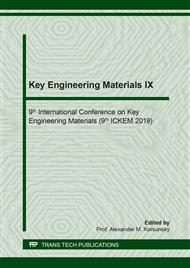p.125
p.131
p.137
p.144
p.153
p.160
p.167
p.174
p.183
Design of Extrusion Die Geometry for Making Sheets from a Mixture of Metal Powder and Polymer
Abstract:
Rheology of polymer-metal powder mixture containing a significant amount of metal powder loading determines its flowability through an extrusion die. To make sheets from such mixtures, geometries based on Coat-hanger, Fishtail and ‘T’ type designs are often used. Flow properties such as flow rate, viscosity, residence time, instantaneous velocity and pressure distribution in different type of dies have been used in simulations in Ansys (CFX or fluent). The present paper describes the special design of the fishtail type die geometry with adjustable part at lip land to make sheets from a polymer-metal powder mixture by extrusion. This also includes the design of primary manifold, tapered pre-land, secondary manifold and lip land geometries to obtain uniform velocity at the exit of the die and as uniform a pressure distribution as possible. It includes designing of suitable die profiles in each of these four zones based on the experimentally established constitutive equations using a Melt Flow Index tester.
Info:
Periodical:
Pages:
153-159
Citation:
Online since:
September 2019
Authors:
Price:
Сopyright:
© 2019 Trans Tech Publications Ltd. All Rights Reserved
Share:
Citation:


